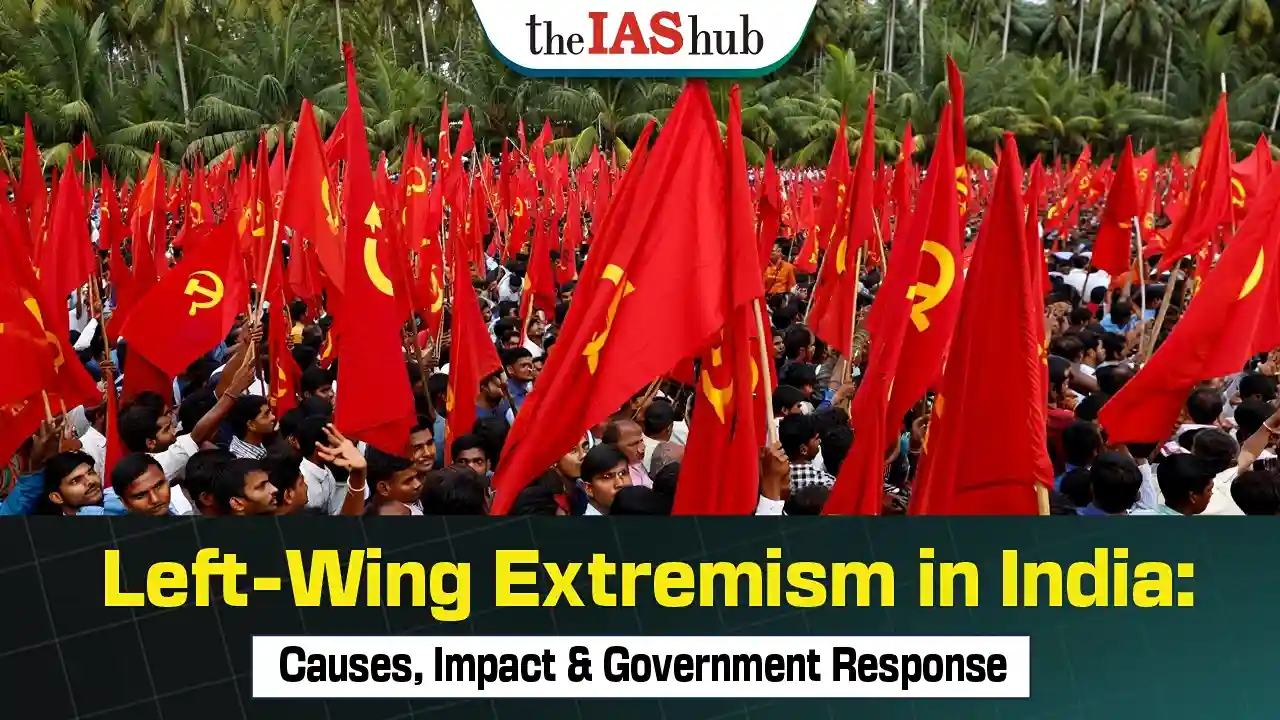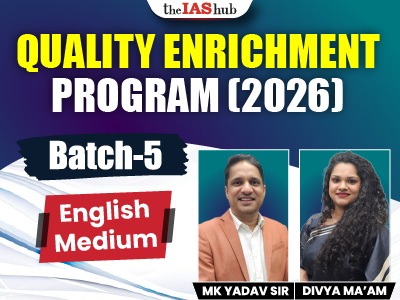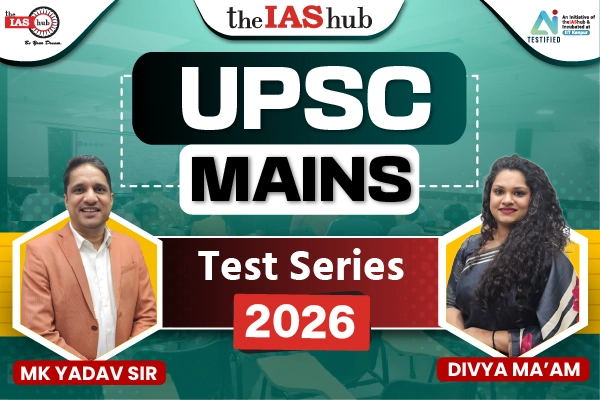Left-Wing Extremism in India (LWE), often associated with the Naxalite-Maoist insurgency, poses one of the most persistent internal security challenges in India. Rooted in deep socio-economic inequalities and tribal alienation, it thrives in underdeveloped regions. A multi-pronged government approach combining security, development, and governance reforms is key to addressing this complex issue.
What is meant by Extremism?
- Extremism advocates adoption of extreme political, social, religious, radical, or revolutionary ideas, beliefs, or actions that reject or undermine the status quo and contemporary ideas and expressions of freedom.
- It involves an intense and uncompromising commitment to a particular ideology, often characterized by a rejection of moderate or mainstream views.
Recent Context of Extremism in India
- April 2023-Ten personnel of the Chhattisgarh Police’s District Reserve Guard (DRG) were reported killed in an IED attack by Maoists in the state’s Dantewada district.

- As per Ministry of Home affairs nearly 70 districts in Red Corridor area affected by Naxalite activities
- The LWE related violence incidents have reduced by 76% from the number of incidents in 2010, while resultant deaths (Civilians + Security Forces) have reduced by 90% from all time high of 1005 in 2010 to 98 in 2022. (Source-Ministry of Home Affairs).
Left-wing extremism (LWE) or Naxal Insurgency
- Left-wing extremists (LWE), popularly known as Maoists worldwide and as Naxalitesin India.
- Origin: From a single village of west Bengal Naxal Bari area, now spreads across 11 states, infamously known as the “Red Corridor”.
- In 2004, the Communist Party of India (Maoist-Leninist), the People’s War (PW), and the Maoist Communist Centre of India (MCCI), merged to form the Communist Party of India (Maoist).
- The CPI (Maoist) Party is the major LWE outfit responsible for a majority of incidents of violence and killing of civilians and security forces.

- Objective of Naxalites - to wage an armed revolution, overthrow the existing democratic state structure with violence as their primary weapon, and usher in their own form of government. For this, they engage in mass mobilization and building strategic united fronts.
- They stridently take up issues like ‘displacement of tribals’, ‘corporate exploitation’, ‘human rights violations’ by security forces etc. and often make fantastic claims in this regard which get reported even by the mainstream media.
- Urban movement is vital for Maoists because this is where they have access to funds, weapons, and a literate cadre that would form a base of leadership to organize masses in rural areas.
Objectives Behind Left-Wing Extremism

Extremism Tactics: Strategies Used by Naxals
- Utilization of guerrilla warfare tactics.
- Recruitment of tribal populations into their ranks.
- Targeting of security forces and infrastructure.
- Establishing links with international extremist groups.
- Engaging in extortion, arms smuggling, and money laundering.
Areas Affected by Left-Wing Extremism

Factors Contributing to Left-Wing Extremism in India
- Discontent with the government among tribal peoples: Loss of livelihood due to forest policy. Massive tribal population displacement in Naxalism-affected states as a result of development projects, mining operations, and other factors.
- Economic factors: Unemployment, poverty, a lack of health care, a lack of education and awareness, a lack of access to electricity, internet connectivity. The wealth divide between affluent and poor is widening.
- Deficiency in governance: Absence of Regular administration in remote locations. Lack of state government measures to address the problem, poor implementation, and mishandling of government schemes.
- Social oppression: Social discrimination faced by the Dalits and other lower caste OBC. This social discrimination creates feelings of alienation.
- Land alienation: Increased marginal landholdings. Weak land reforms which lead to insecurity and exploitation of tenants.
- Delayed process of adjudication: Slow judicial system. The same slow system which creates frustration which ends up with illegal extremist mind framework.
- Rehabilitation: Tribal people who displaced due to development project not rehabilitated properly. This causes people to experience multidimensional trauma, which has major repercussions.
- Common property resources (CPR): CPR includes such as community pasture, watershed drainages, village tanks etc. These CRR are sustainable to local communities. But due to industrialisation, privatization and development projects, the CPRs area is shrinking and the government. never look into this matter.
- Environment degradation: Mineral extraction, deforestation creating problems like land degradation. These environmental problems push already vulnerable people more towards poverty.
GoI’s approach for Left-Wing Extremism Areas
- The Government’s approach is to deal with LWE in a holistic manner, in the areas of security, development, ensuring rights and entitlements of local communities, improvement in governance and public perception management.
- 'Police' and 'Public Order' being State subjects, action on maintenance of law and order, lies primarily in the domain of the State Governments.
- However, the Central Government closely monitors the situation and supplements and coordinates their efforts in several ways. These include
- Providing the Central Armed Police Forces (CAPFs);
- Sanction of India Reserve (IR) battalions,
- Setting up of Counter Insurgency and Anti-Terrorism (CIAT) schools;
- Modernization and upgradation of the State Police and their Intelligence apparatus;
- Reimbursement of security related expenditure under Security-related Expenditure (SRE) Scheme;
- Providing helicopters for anti-LWE operations,
- Assistance in training of State Police through the Ministry of Defence, the Central Police Organisations and the Bureau of Police Research and Development;
- Sharing of Intelligence;
- Facilitating inter-State coordination;
- Assistance in community policing and civic action programmes
- The underlying philosophy is to enhance the capacity of the State Governments to tackle the Maoist menace in a concerted manner.

Key Initiatives to Combat Left-Wing Extremism
- GoI has approved a new vertical i. Left-Wing Extremism (LWE) Cell, in NIA.
- National Policy and Action Plan - to holistically address the LWE problem by adopting multi-pronged strategy in the areas of security, development, ensuring rights & entitlement of local communities etc.
- Initiatives under Umbrella Scheme Modernization of Police Forces
- Security Related Expenditure (SRE) Scheme – Under this the central Govt. reimburses to the State Governments of 11 LWE affected States Security Related Expenditure relating to training and operational needs of the security forces.
- Special Central Assistance (SCA) for 30 most LWE affected districts - to fill the critical gaps in Public infrastructure and Services, which are of emergent nature.
- Special Infrastructure Scheme - To fill the critical infrastructure gaps that are not covered under existing government schemes, including construction of Fortified Police Stations, etc.
- Assistance to Central Agencies for LWE management Scheme for strengthening of infrastructure and hiring charges for Helicopters.
- Civic Action Programme (CAP) - To bridge the gaps between Security Forces (SF) and local people through personal interaction and bring the human face of SFs before the local population.
- Media Plan – for Public Perception Management. Under the scheme, activities like Tribal Youth Exchange programmes, radio jingles, documentaries, pamphlets etc. are being conducted.
- Setting up of Bastariya battalion in Central Reserve Police Force (CRPF) from Schedule Tribes belonging to 4 districts of Bastar in Chattisgarh to carry out combats.
- Infrastructure & Socio Economic Development schemes
- Aspirational District programme in LWE affected districts.
- Other schemes/Initiatives – MGNREGA, Van Bandhu Kalyan Yojana, PM Gram Sadak yojana, National Health Mission, Skill Development (for eg. ROSHINI scheme for rural poor youth), Setting up Eklavya schools, Forest Rights Act, 2006, District Mineral Funds (DMF) etc.
- Surrender Cum Rehabilitation Policy
Conclusion
Addressing LWE extremism necessitates a comprehensive approach that tackles root causes, promotes inclusive dialogue, upholds democratic principles, and emphasizes security and prevention. By doing so, societies can work towards mitigating the impact of LWE extremism and fostering a more peaceful and inclusive future.
















